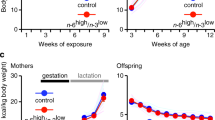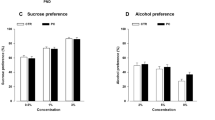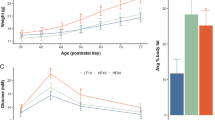Abstract
Consumption of a high-fat diet has been linked to obesity, dyslipidemia and cardiovascular disease. Less well appreciated are adverse effects on the brain and behavior. Recent research has shown that consumption of a high-fat diet can alter gene expression within the brain, and the dopamine and opioid neurotransmitter systems appear to be vulnerable to dysregulation. This review will focus on recent reports in both humans and animal models that describe adverse effects of high-fat diet consumption on the central reward circuitry. In addition, the importance of different development windows will be discussed, with effects observed in both the prenatal/perinatal time period and with chronic high-fat diet consumption in adulthood.
This is a preview of subscription content, access via your institution
Access options
Subscribe to this journal
We are sorry, but there is no personal subscription option available for your country.
Buy this article
- Purchase on Springer Link
- Instant access to full article PDF
Prices may be subject to local taxes which are calculated during checkout
Similar content being viewed by others
References
Bassareo V, Chiara GD . Differential responsiveness of dopamine transmission to food-stimuli in nucleus accumbens shell/core compartments. Neuroscience 1999; 89: 637–641.
Koob GF, Moal ML . Drug abuse: hedonic homeostatic dysregulation. Science 1997; 278: 52–58.
Rebec GV, Christensen JR, Guerra C, Bardo MT . Regional and temporal differences in real-time dopamine efflux in the nucleus accumbens during free-choice novelty. Brain Res 1997; 776: 61–67.
David HN, Abraini JH . Group III metabotropic glutamate receptors and D1-like and D2-like dopamine receptors interact in the rat nucleus accumbens to influence locomotor activity. Eur J Neurosci 2002; 15: 869–875.
Reymond MJ, Porter JC . Involvement of hypothalamic dopamine in the regulation of prolactin secretion. Horm Res 1985; 22: 142–152.
Meguid MM, Fetissov SO, Varma M, Sato T, Zhang L, Laviano A et al. Hypothalamic dopamine and serotonin in the regulation of food intake. Nutrition 2000; 16: 843–857.
Vucetic Z, Reyes TM . Central dopaminergic circuitry controlling food intake and reward: implications for the regulation of obesity. Wiley Interdiscip Rev Syst Biol Med 2010; 2: 577–593.
Weiner DM, Levey AI, Sunahara RK, Niznik HB, O’Dowd BF, Seeman P et al. D1 and D2 dopamine receptor mRNA in rat brain. Proc Natl Acad Sci USA 1991; 88: 1859–1863.
Mansour A, Watson SJ . Dopamine receptor expression in the central nervous system. In: Bloom FE, Kupfer DJ (eds). Psychopharmacology: The Fourth Generation of Progress. Raven Press: New York, NY, USA, 1995, pp 207–219.
Barbano MF, Cador M . Opioids for hedonic experience and dopamine to get ready for it. Psychopharmacology (Berl) 2007; 191: 497–506.
Le Merrer J, Becker JA, Befort K, Kieffer BL . Reward processing by the opioid system in the brain. Physiol Rev 2009; 89: 1379–1412.
Zhang M, Gosnell BA, Kelley AE . Intake of high-fat food is selectively enhanced by mu opioid receptor stimulation within the nucleus accumbens. J Pharmacol Exp Ther 1998; 285: 908–914.
Yogev Y, Catalano PM . Pregnancy and obesity. Obstet Gynecol Clin North Am 2009; 36: 285–300.
Bodnar LM, Siega-Riz AM, Simhan HN, Himes KP, Abrams B . Severe obesity, gestational weight gain, and adverse birth outcomes. Am J Clin Nutr 2010; 91: 1642–1648.
Oken E, Kleinman KP, Belfort MB, Hammitt JK, Gillman MW . Associations of gestational weight gain with short- and longer-term maternal and child health outcomes. Am J Epidemiol 2009; 170: 173–180.
Rodrigues PL, de Oliveira LC, Brito Ados S, Kac G . Determinant factors of insufficient and excessive gestational weight gain and maternal-child adverse outcomes. Nutrition 2010; 6: 617–623.
Lawlor DA, Lichtenstein P, Fraser A, Långström N . Does maternal weight gain in pregnancy have long-term effects on offspring adiposity? A sibling study in a prospective cohort of 146,894 men from 136,050 families. Am J Clin Nutr 2011; 94: 142–148.
Heude B, Thiébaugeorges O, Goua V, Forhan A, Kaminski M, Foliguet B et al. Pre-Pregnancy Body Mass Index and Weight Gain During Pregnancy: Relations with Gestational Diabetes and Hypertension, and Birth Outcomes. Matern Child Health J 2012; 16: 355–363.
Ehrenberg HM, Mercer BM, Catalano PM . The influence of obesity and diabetes on the prevalence of macrosomia. Am J Obstet Gynecol 2004; 191: 964–968.
Mehta SH, Kruger M, Sokol RJ . Is maternal diabetes a risk factor for childhood obesity? J Matern Fetal Neonatal Med 2012; 25: 41–44.
Lawlor DA, Lichtenstein P, Långström N . Association of maternal diabetes mellitus in pregnancy with offspring adiposity into early adulthood: sibling study in a prospective cohort of 280,866 men from 248,293 families. Circulation 2011; 123: 258–265.
Boerschmann H, Pflüger M, Henneberger L, Ziegler AG, Hummel S . Prevalence and predictors of overweight and insulin resistance in offspring of mothers with gestational diabetes mellitus. Diabetes Care 2010; 33: 1845–1849.
Pirkola J, Pouta A, Bloigu A, Hartikainen AL, Laitinen J, Järvelin MR et al. Risks of overweight and abdominal obesity at age 16 years associated with prenatal exposures to maternal prepregnancy overweight and gestational diabetes mellitus. Diabetes Care 2010; 33: 1115–1121.
Leonard H, Nassar N, Bourke J, Blair E, Mulroy S, de Klerk N et al. Relation between intrauterine growth and subsequent intellectual disability in a ten-year population cohort of children in Western Australia. Am J Epidemiol 2008; 17: 103–111.
Schendel D, Bhasin TK . Birth weight and gestational age characteristics of children with autism, including a comparison with other developmental disabilities. Pediatrics 2008; 121: 1155–1164.
Alati R, Najman JM, O’Callaghan M, Bor W, Williams GM, Clavarino A . Fetal growth and behaviour problems in early adolescence: findings from the Mater University Study of Pregnancy. Int J Epidemiol 2009; 38: 1390–1400.
Rodriguez A . Maternal pre-pregnancy obesity and risk for inattention and negative emotionality in children. J Child Psychol Psychiatry 2010; 51: 134–143.
Ray GT, Croen LA, Habel LA . Mothers of children diagnosed with attention-deficit/hyperactivity disorder: health conditions and medical care utilization in periods before and after birth of the child. Med Care 2009; 47: 105–114.
Rodriguez A, Miettunen J, Henriksen TB, Olsen J, Obel C, Taanila A et al. Maternal adiposity prior to pregnancy is associated with ADHD symptoms in offspring: evidence from three prospective pregnancy cohorts. Int J Obes (Lond) 2008; 32: 550–557.
Ornoy A . Growth and neurodevelopmental outcome of children born to mothers with pregestational and gestational diabetes. Pediatr Endocrinol Rev 2005; 3: 104–113.
Bilbo SD, Tsang V . Enduring consequences of maternal obesity for brain inflammation and behavior of offspring. FASEB J 2010; 24: 2104–2115.
Sullivan EL, Grayson B, Takahashi D, Robertson N, Maier A, Bethea CL et al. Chronic consumption of a high-fat diet during pregnancy causes perturbations in the serotonergic system and increased anxiety-like behavior in nonhuman primate offspring. J Neurosci 2010; 30: 3826–3830.
Tozuka Y, Kumon M, Wada E, Onodera M, Mochizuki H, Wada K . Maternal obesity impairs hippocampal BDNF production and spatial learning performance in young mouse offspring. Neurochem Int 2010; 57: 235–247.
Chang GQ, Gaysinskaya V, Karatayev O, Leibowitz SF . Maternal high-fat diet and fetal programming: increased proliferation of hypothalamic peptide-producing neurons that increase risk for overeating and obesity. J Neurosci 2008; 28: 12107–12119.
Gupta A, Srinivasan M, Thamadilok S, Patel MS . Hypothalamic alterations in fetuses of high fat diet-fed obese female rats. J Endocrinol 2009; 200: 239–300.
Bouret SG, Gorski JN, Patterson CM, Chen S, Levin BE, Simerly RB . Hypothalamic neural projections are permanently disrupted in diet-induced obese rats. Cell Metab 2008; 7: 179–185.
Steculorum SM, Bouret SG . Maternal diabetes compromises the organization of hypothalamic feeding circuits and impairs leptin sensitivity in offspring. Endocrinology 2011; 152: 4171–4179.
Le Foll C, Irani BG, Magnan C, Dunn-Meynell A, Levin BE . Effects of maternal genotype and diet on offspring glucose and fatty acid-sensing ventromedial hypothalamic nucleus neurons. Am J Physiol Regul Integr Comp Physiol 2009; 297: R1351–R1357.
Grayson BE, Levasseur PR, Williams SM, Smith MS, Marks DL, Grove KL . Changes in melanocortin expression and inflammatory pathways in fetal offspring of nonhuman primates fed a high-fat diet. Endocrinology 2010; 151: 1622–1632.
Chen H, Morris MJ . Differential responses of orexigenic neuropeptides to fasting in offspring of obese mothers. Obesity (Silver Spring) 2009; 17: 1356–1362.
Bayol SA, Farrington SJ, Stickland NC . A maternal ‘junk food’ diet in pregnancy and lactation promotes an exacerbated taste for ‘junk food’ and a greater propensity for obesity in rat offspring. Br J Nutr 2007; 98: 843–851.
Ong ZY, Muhlhausler BS . Maternal ″junk-food″ feeding of rat dams alters food choices and development of the mesolimbic reward pathway in the offspring. FASEB J 2011; 25: 2167–2179.
Naef L, Moquin L, Dal Bo G, Giros B, Gratton A, Walker CD . Maternal high-fat intake alters presynaptic regulation of dopamine in the nucleus accumbens and increases motivation for fat rewards in the offspring. Neuroscience 2011; 176: 225–236.
Teegarden SL, Scott AN, Bale TL . Early life exposure to a high fat diet promotes long-term changes in dietary preferences and central reward signaling. Neuroscience 2009; 162: 924–932.
Shalev U, Tylor A, Schuster K, Frate C, Tobin S, Woodside B . Long-term physiological and behavioral effects of exposure to a highly palatable diet during the perinatal and post-weaning periods. Physiol Behav 2010; 101: 494–502.
Naef L, Srivastava L, Gratton A, Hendrickson H, Owens SM, Walker CD . Maternal high fat diet during the perinatal period alters mesocorticolimbic dopamine in the adult rat offspring: reduction in the behavioral responses to repeated amphetamine administration. Psychopharmacology (Berl) 2008; 197: 83–94.
Wright TM, Fone KC, Langley-Evans SC, Voigt JP . Exposure to maternal consumption of cafeteria diet during the lactation period programmes feeding behaviour in the rat. Int J Dev Neurosci 2011; 29: 785–793.
Vucetic Z, Kimmel J, Totoki K, Hollenbeck E, Reyes TM . Maternal high-fat diet alters methylation and gene expression of dopamine and opioid-related genes. Endocrinology 2010; 151: 4756–4764.
Kenny PJ . Common cellular and molecular mechanisms in obesity and drug addiction. Nat Rev Neurosci 2011; 12: 638–651.
Berthoud HR . Metabolic and hedonic drives in the neural control of appetite: who is the boss? Curr Opin Neurobiol 2011; 21: 888–896.
Volkow ND, Wang GJ, Baler RD . Reward, dopamine and the control of food intake: implications for obesity. Trends Cogn Sci 2011; 15: 37–46.
Kenny PJ . Reward mechanisms in obesity: new insights and future directions. Neuron 2011; 69: 664–679.
Horstmann A, Busse FP, Mathar D, Müller K, Lepsien J, Schlögl H et al. Obesity-related differences between women and men in brain structure and goal-directed behavior. Front Hum Neurosci 2011; 5: 58.
Stice E, Yokum S, Burger KS, Epstein LH, Small DM . Youth at risk for obesity show greater activation of striatal and somatosensory regions to food. J Neurosci 2011; 31: 4360–4366.
Stice E, Yokum S, Blum K, Bohon C . Weight gain is associated with reduced striatal response to palatable food. J Neurosci 2010; 30: 13105–13109.
Johnson PM, Kenny PJ . Dopamine D2 receptors in addiction-like reward dysfunction and compulsive eating in obese rats. Nat Neurosci 2010; 13: 635–641.
Speed N, Saunders C, Davis AR, Owens WA, Matthies HJ, Saadat S et al. Impaired striatal Akt signaling disrupts dopamine homeostasis and increases feeding. PLoS One 2011; 6: e25169.
Alsiö J, Olszewski PK, Norbäck AH, Gunnarsson ZE, Levine AS, Pickering C et al. Dopamine D1 receptor gene expression decreases in the nucleus accumbens upon long-term exposure to palatable food and differs depending on diet-induced obesity phenotype in rats. Neuroscience 2010; 171: 779–787.
Davis JF, Tracy AL, Schurdak JD, Tschöp MH, Lipton JW, Clegg DJ et al. Exposure to elevated levels of dietary fat attenuates psychostimulant reward and mesolimbic dopamine turnover in the rat. Behav Neurosci 2008; 122: 1257–1263.
Geiger BM, Haburcak M, Avena NM, Moyer MC, Hoebel BG, Pothos EN . Deficits of mesolimbic dopamine neurotransmission in rat dietary obesity. Neuroscience 2009; 159: 1193–1199.
Shin AC, Pistell PJ, Phifer CB, Berthoud HR . Reversible suppression of food reward behavior by chronic mu-opioid receptor antagonism in the nucleus accumbens. Neuroscience 2010; 170: 580–588.
Kelley AE, Baldo BA, Pratt WE . A proposed hypothalamic-thalamic-striatal axis for the integration of energy balance, arousal, and food reward. J Comp Neurol 2005; 493: 72–85.
Vucetic Z, Kimmel J, Reyes TM . Chronic high fat diet drives postnatal epigenetic regulation of m-opioid receptor in the brain. Neuropsychopharmacology 2011; 36: 1199–1206.
Vucetic Z, Carlin JL, Totoki K, Reyes TM . Epigenetic dysregulation of the dopamine system in diet-induced obesity. J Neurochem 2012; 120: 891–898.
Ranaldi R, Pocock D, Zereik R, Wise RA . Dopamine fluctuations in the nucleus accumbens during maintenance, extinction, and reinstatement of intravenous D-amphetamine self-administration. J Neurosci 1999; 19: 4102–4109.
Acknowledgements
Dr Reyes is supported by grants from NIH (MH087978 and MH091372), as well as a NARSAD Young Investigator Award.
Author information
Authors and Affiliations
Corresponding author
Ethics declarations
Competing interests
The author declares no conflict of interest.
Additional information
This article was published as part of a supplement funded with an unrestricted educational contribution from Desjardins Sécurité Financière.
Rights and permissions
About this article
Cite this article
Reyes, T. High-fat diet alters the dopamine and opioid systems: effects across development. Int J Obes Supp 2 (Suppl 2), S25–S28 (2012). https://doi.org/10.1038/ijosup.2012.18
Published:
Issue Date:
DOI: https://doi.org/10.1038/ijosup.2012.18
Keywords
This article is cited by
-
α-Dystrobrevin knockout mice have increased motivation for appetitive reward and altered brain cannabinoid receptor 1 expression
Acta Neuropathologica Communications (2022)



